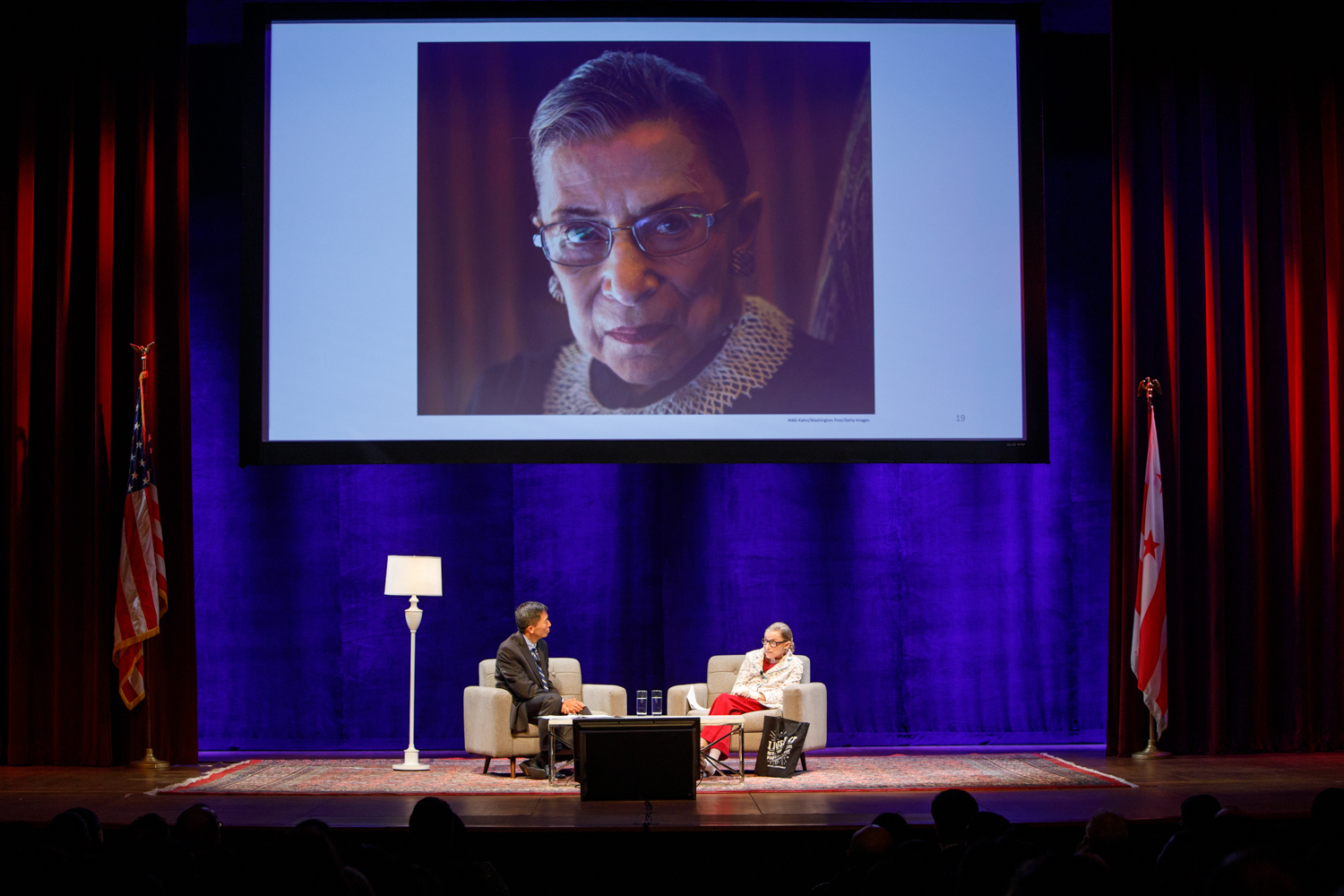By Tatyana Hopkins
U.S. Supreme Court Justice Ruth Bader Ginsburg celebrated a milestone work anniversary in August—25 years as a judge on the nation’s highest court. But long before recognition of her groundbreaking legal career made her the subject of a documentary and an upcoming Hollywood film, Justice Ginsburg was one of only nine women in her Harvard Law class of 500 students.
She later became one of only 11 federal circuit court judges appointed by President Jimmy Carter and the first woman hired at Columbia Law with tenure.
Justice Ginsburg recalled for an audience in Lisner Auditorium Wednesday that the search for her first job after law school in 1959—at a time where no federal laws prohibited employers from discriminating against applicants—was one of the toughest periods of her legal career.
She said being Jewish, a woman and the mother of a then-small child were the reasons she had such a hard time finding work despite having tied for the top position in her graduating class at Columbia.
“I had three strikes against me,” Justice Ginsburg said.
Justice Ginsburg came to the George Washington University to speak about diversity and inclusion in the legal profession at an event hosted by GW Law and presented by the National Asian Pacific American Bar Association (NAPABA). California Supreme Court Associate Justice Goodwin H. Liu, Ms. Ginsburg’s former law clerk, moderated the discussion.
GW Law Dean Blake D. Morant called the event “timely” in his introductory remarks.
“GW Law always seeks to bring contemporary programming to the community here, and especially to our students,” he said. “Of course, we all know the legendary Justice Ruth Bader Ginsburg.”
Mr. Morant said Justice Ginsburg personified words of advice he often offers to students: “The true definition of a great professional is not only the person that has distinguished herself as an absolute stellar individual in the law but is also the individual that gives of herself to the community.”
Justice Ginsburg said after graduation she worked at a well-known firm as a summer associate and despite her hard work, no offer for a permanent job was made. The reason—the firm had already offered a position to another woman, Pauli Murray.
“Pauli was what you then called a ‘twofer,’” Justice Ginsburg said. “This is, Pauli was both African American and a female. So, the firm didn’t have to show how avant-garde they were. They had Pauli, and they didn’t need another.”
She said for women in the legal profession from that era, finding and keeping the first job was “powerfully hard.”
“But once you got that first job, the woman generally performed at least as well as the man,” she said. “So, the second job wasn’t a problem. But getting your foot in that door was very hard.”
NAPABA President Pankit J. Doshi said the legal profession has since made progress in matters of diversity but still has work to do to continue the growth of diversity and inclusion.
NAPABA, which is celebrating its 30th anniversary this year, represents more than 50,000 Asian Pacific American judges, law students and other legal professionals nationwide.
“Today, we continue an important conversation about diversity and breaking barriers,” Mr. Doshi said. “We recognize diversity as a strength.”
Justice Ginsburg agreed that there is still work to be done for the legal profession to be more inclusive.
She said employers creating flexible schedules and acknowledging implicit biases, especially in the hiring process, will be key to creating more opportunities for candidates of diverse backgrounds. This, she said, would eliminate barriers for women and members of minority groups and allow them to enter the legal profession “in numbers rather than as one-at-a-time curiosities.”
In addition to speaking about her life and career, Justice Ginsburg also spoke about what she called the “partisan” nature of the current confirmation process for President Donald Trump’s Supreme Court nominee Brett Kavanaugh.
“The way it was, was right. The way it is, is wrong,” she said referring to Supreme Court confirmations in the past, including her own.
She said the atmosphere of her confirmation “was truly bipartisan,” noting she had gained the vote of nearly every Republican senator despite her decade-long work with the American Civil Liberties Union.
President Bill Clinton nominated Justice Ginsburg to the Supreme Court in June 1993, and two months later the Senate voted to 96-3 to confirm her.
“That’s the way it should be instead of what its become, which is a highly partisan show,” she said. “The Republicans move in lockstep, and so do the Democrats. I wish I could wave a magic wand and bring it back to the way it was.”



